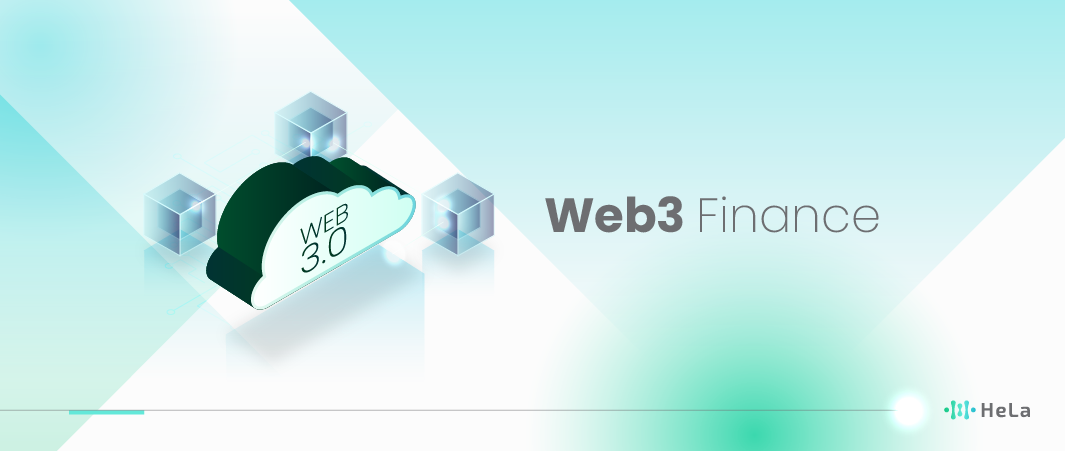Over the last few years, during which Web3 finance came out as a revolution for the financial world, the financial system has significantly changed across the globe. In essence, web3 finance is about the upheaval of the institutional world of the financial sphere, with all that comes with it: new possibilities for innovation, equality, and security. However, stimulating the slow march of progress is not the only implication of Web3 finance. It points the way to a brand new type of financial infrastructure that is decentralized and transparent.
Through intermediaries’ elimination, Web3 finance dramatically decreases friction, lowers costs, and improves efficiency in financial interactions that undoubtedly affect both individuals and groups in the economy globally in a beneficial manner. A term called “Web3” describes Web3, which means the next evolution of the whole Internet model and has decentralization, interoperability, as well as enhanced safety features. This approach involves designing Web3 finance to change conventional financial patterns by making use of decentralized blockchain technology and DeFi solutions. Finding out about the main features and consequences of this key discovery within the given field will be our goal.
What is Web3 Finance?

We are witnesses to a financial revolution, a new mode of finance; Web 3, as decentralized finance (DeFi), is intense, as it seeks to bring on the side of centralized systems that benefit from blockchain technology. Unlike traditional institutional capital constructed on the foundation of middlemen such as banks, brokers, and clearing houses that have an important role in facilitating transactions, Web3 finance runs through decentralized networks where the transactions go through directly between the users and smart contracts.
These contracts are called “smart contracts”, and no third party or mediator is required since they are self-executing agreements with the conditions of the contract being programmed in the code. Therefore, transparency and trust are fundamentally guaranteed. This decentralization provides personal voting power by giving individuals more opportunities to direct and govern financial activities, which in the end reduces dependence on centralized institutions and the occurrence of censorship or manipulation.
At the core of Web3 finance, you will find decentralized applications, or (dApps) that run on the blockchain with functionalities ranging from trade, loans/borrowing, asset management, and much more. DEXs are second to none due to the fact they are decentralized, which allows peer-to-peer trading of digital coins without the need for a central authority, which secures better liquidity, transparency and security. These platforms, which include Uniswap, SushiSwap, and PancakeSwap, have become increasingly popular for the decentralized exchange protocols connecting the user’s balances with the desired tokens and making the trading smooth.
Furthermore, lending and borrowing procedures are as important as the lending and borrowing protocols in Web3 Finance. The way users can earn interest by lending their assets or by borrowing assets by providing collateral is all done through smart contracts. The ”Aave, Compound, and MakerDAO” protocols are significant players in the DeFi field, rendering the prospect of earning passive income or accessing liquidity no longer dependent on credit checks or the roles of intermediaries.
On the other hand, yield farming and liquidity mining have also come on the scene, which are two popular strategies in Web3 finance, and they provide incentivization to users by rewarding them with further tokens if they provide liquidity to various DeFi protocols. The purpose of this strategy is to gain the most return possible by devising a plan that shares the assets on different DeFi platforms, which comes with risks such as the liquidity risk of crypto assets and smart contract risk.
Also Read: Top 5 Layer 1 Crypto Projects Stand as Pillars of Innovation in 2023
Decentralized autonomous organizations (DAO) are the third core component of Web3, enabling decentralized self-governance via community driven projects, and also executing community decisions. Through smart contracts and tokens’ governed holders, the redistribution of the funds and cooperation apps becomes possible. DAOstack and Aragon are some of the various kinds of projects that provide the chance to create and run DAOs that would help the decentralization of the management and governance of systems.
Major Web3 cryptocurrency promises and opportunities should not dazzle your eyes and stop you from noticing its challenges as well. The decentralized finance (DeFi) system has intricate ecosystems, which are comprised of complex hurdles such as scalability, interoperability, security, and regulatory compliance. These are some of the key hurdles to the actualization of the DeFi ecosystem’s complete manifestation as a mainstream economic infrastructure.
In essence, learning about Web3 finance involves exploring the principles of blockchain technology, smart contracts, decentralized applications, and the dynamic field of decentralized finance, as we face potential dangers and opportunities arising from this novel approach.
Web3 Finance Implications and Opportunities

In Web3 finance, where it’s distributed and trustless, you may find that it can bring not just opportunities but also major implications that are not available in the classical financial ecosystem. Here’s a deeper dive into some of the key aspects:Here’s a deeper dive into some of the key aspects:
Financial Inclusion
Web3 finance opens a way out for increasing currency inclusion by giving people belonging to isolated regions the possibility of using financial services. However, in many areas, conventional banking infrastructure is either not reachable, or it is too costly for somebody too pay, so they’re now decidedly deprived of financial services like savings accounts, borrowings and insurance.
Web3 finances, empowered by blockchain technology and decentralized apps (DApps), provide an ideal option in this respect, as they offer every person the ability to join global financial markets directly using smartphones or computers. Under the conditions of KYC compliance and anti-money laundering procedures, some unbankable individuals can get access to capital, obtain credit for their activities, and earn interest rates on their savings using distributed lending platforms, stablecoins, or remittance services. Also, the decentralized finance protocols foster transparency, affordability, and inclusiveness among people and therefore, financial services become more available to the excluded populations and, therefore, individuals acquire the power to create their financial futures.
Global Access to Capital
An amazing power of financial capitalism in Web3 is that it gives an individual anywhere in the world a chance to participate in the financial market of the country. Until recently, the manner in which capital is raised for entrepreneurial enterprises and investment opportunities, despite being restricted to the so-called financial hubs and accredited investors, has created a cooling effect on the attractiveness and accessibility to individuals and informal organizations in emerging markets.
Although DeFi enthusiasts are having a field day and any user with an internet connection can avail capital from a global pool of liquidity, it is also affecting the position of traditional financial institutions. Through peer-to-peer lending, Initial Coin Offering (ICO), and fundraising with the crowdfunding base, entrepreneurs, startups, and small and medium size enterprises can raise finances from a range of investors, excluding intermediaries and usual banking channels. This is why not only new sources of capital for innovative projects are opened up, but these facilitate the growth of the economy via the creation of jobs and innovation in regions that before were not served by traditional financial institutions. Also, the decentralized finance protocols provide programmable financial instruments like tokenized securities, derivatives and decentralized exchanges that enable capital distribution worldwide, risk management and diversification options with greater efficiency.
Disintermediation
It is restructuring the conventional finance framework depicted by the channel categories of centralized banking, mass clearinghouses, and widely used brokers. In traditional finance, these intermediaries have a quite important role as they can be included in transaction facilitation, asset management and financial service provision. Although this presents the benefits of low transactional costs, increased security and all-inclusive properties, their centralized nature makes them prone to inefficiencies, high fees, and single points of failure, which pose systemic risks and entry barriers to individual users and businesses.
Web3 finance, in this sense, incorporates blockchain technology and smart contracts to make them able to smartly automate financial processes and eliminate intermediaries. In this regard, they also make sure that the trustless transaction takes place between the counterparties. Decentralized exchanges such as DEXs which operate on the personal trading of digital assets without depending on the central authorities, do provide platforms such as greater liquidity, transparency and security.
Moreover, the technology has the equivalent of assisting persons to get credit, loan or maturity interest on their assets without the need for banks and financial institutions,which ensures a reduction of counterparty risk and efficient capital distribution. Through the term Web3 finance, which consists of intermediary financial organs, financial autonomy, stability, and innovation are brought into effect while at the same time reducing costs and offering a wide range of financial services to individuals and businesses, thus allowing them to access such services worldwide.
Democratization of Financial Services
Web 3 Finance thus democratizes the finance industry by eliminating the middleman and giving the power back to the people so they can control the protocols or decentralized applications themselves. Under centralized financial systems, decision-making is largely the preserve of a few powerful actors, central banks, regulators and governments, with no sign of transparency, accountability or public participation in the decision-making process.
Although Web3 Finance provides a support system for decentralized autonomous organizations (DAOs) which are governed by smart contracts, the token holders are empowered to drive and govern financial resources in a democratic, decentralized, and transparent manner.
DAOs have become a platform for community members to pledge tributes or vote on and fund new initiatives, projects and other protocol improvements to ensure a culture of unhindered innovation, collaboration and inclusion within the decentralized finance world. Likewise, governance tokens offer users somehow ownership in emerging decentralized apps and protocols, thereby encouraging them to take an active part, maintain a vibrant community, and ensure long term project sustainability.
The democratization of access to financial products and services, as well as the decision-making process, has been a driving force behind the increased social equity, resilience, and empowerment that we have witnessed in Web3 finance; consequently, the evolution of an inclusive and transparent financial space for all the involved participants has been concretized in the process.
Challenges and Considerations in Web3 Finance

The reality of Web3 finance is not simply a matter of negotiating obstacles and integrating new regulations; this is a much wider and more important issue. Here’s a deeper exploration of some key challenges and considerations in Web3 finance:Here’s a deeper exploration of some key challenges and considerations in Web3 finance:
Scalability
Web3 Finance’s inability to scale is one of its most essential drawbacks. The public blockchain network, especially Ethereum, which supports many decentralized finance applications, may get overloaded and transaction fees may increase during times of high traffic.
With the rapid growing popularity of decentralized financial technologies, scalability is increasingly important to support over hundred-million users and the expansion of various financial activities. For instance, solutions like layer 2, sharding, and alternative blockchain networks serve to aid the scalability process, but achieving true scalability while maintaining aspects of trust and security remains an engineering problem that is complex to solve.
Interoperability
A blockchain network can be considered interoperable if it conducts transactions and transfers assets flawlessly among different networks. In the extremely complicated frontier of Web3 finance, interoperability is construed as an essential feature for setting up the architecture of multiple chains, for technical reasons like data sharing and asset transferability.
Though the implication of interoperability among multi-layered and cross-blockchain networks is undisputable, it is also evident that the development of the necessary technical infrastructure and coordination between the different blockchain networks with their diverse consensus mechanisms, smart contract standards, and governance models is a daunting task. Brief the Web3 ecosystem with Polkadot, Cosmos and the interoperability protocols to find a way to bridge the gap among different blockchains and the problem of seamless interoperability is still being faced.
Also Read: Top 10 Fastest Blockchain Platforms in 2024
Regulatory Uncertainty
The web of risk securities around Web3 finance is still expanding, and financial market supervisors all over the world are attempting to find out the position and regulatory authority of decentralized finance activities. Lack of a regulatory framework creates difficulties for web3 finance developers, investors, and users because balanced and consistent regulations result in a good environment for innovations, while unclear or inconsistent regulations hinder innovation, amplify compliance costs, and create legal risks.
AML/KYC regulations, tax reporting requirements, securities laws, etc. point to the fact that decentralized finance operations are complicated, and inevitably, some entities might find constraints in participating in the market. Considering the introduction of proper legal clarity and having clear compliance frameworks as steps in Web3 finance, any concerns connected with its regulation can be dealt with.
Conclusion
At the heart of Web3 finance is the concept of decentralization, which shifts control and ownership of financial assets and services from centralized institutions to individual users. Decentralized finance (DeFi) platforms enable users to access a wide range of financial services, including lending, borrowing, trading, and asset management, without relying on banks, brokers, or other intermediaries. Through decentralized exchanges (DEXs), liquidity pools, and automated market makers (AMMs), users can trade digital assets directly with one another, bypassing traditional exchanges and settlement systems.
Moreover, decentralized lending protocols, such as Aave and Compound, allow users to borrow and lend assets using smart contracts without the need for credit checks or collateral requirements. This democratization of financial services not only increases access to capital and investment opportunities but also promotes financial inclusion and economic empowerment for underserved populations worldwide.
However, despite its transformative potential, Web3 finance faces several challenges and considerations that must be addressed to realize its full potential. Scalability remains a significant concern, as blockchain networks struggle to handle the growing demand for decentralized applications and transactions. Ethereum, the most popular blockchain for DeFi applications, has faced congestion and high transaction fees during periods of peak usage, highlighting the need for scalable solutions such as layer 2 scaling solutions and alternative blockchain networks. Interoperability is another challenge, as different blockchain networks often operate in silos, limiting the flow of assets and data between different platforms and ecosystems. Achieving seamless interoperability among diverse blockchains requires coordination, standardization, and technical innovation to enable cross-chain transactions and data sharing.
Disclaimer: The information provided by HeLa Labs in this article is intended for general informational purposes and does not reflect the company’s opinion. It is not intended as investment advice or a recommendation. Readers are strongly advised to conduct their own thorough research and consult with a qualified financial advisor before making any financial decisions.

In the role of a Hela writer, I weave stories that reveal the core of this revolutionary Layer-1 solution. Created in partnership with accomplished engineers, scientists, and A*STAR IHPC, Hela is tailored for real-world use
-
Alifia Berizkyhttps://helalabs.com/blog/author/alifiabm/
-
Alifia Berizkyhttps://helalabs.com/blog/author/alifiabm/
-
Alifia Berizkyhttps://helalabs.com/blog/author/alifiabm/
-
Alifia Berizkyhttps://helalabs.com/blog/author/alifiabm/

